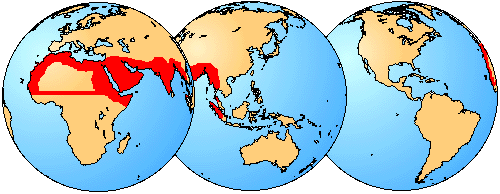Rhinopomatoidea
Nancy B. Simmons and Tenley Conway- Rhinopomatidae (Mouse-tailed Bats)
- Craseonycteridae (Bumblebee Bat)
Introduction
Rhinopomatoidea is an Old World superfamily that includes only two families (Rhinopomatidae and Craseonycteridae), each of which contains a single genus (Simmons, 1998; Simmons and Geisler, 1998). Craseonycteridae contains only one species, Craseonycteris thonglongyai, which at 2 grams is one of the smallest mammals in the World. This interersting species was discovered for the first time in Thailand in 1973, and Craseonycteridae is therefore the most recently described family of bats (Hill, 1974). Four species of Rhinopomatidae are currently recognized (Van Cakenberghe and de Vree, 1994).
Characteristics
All rhinopomatoids are insectivores that capture their prey on the wing. Rhinopomatids occur in arid and semiarid habitats, where they roost in large numbers in caves, openings in rock walls, and man-made structures including houses, wells, tunnels, tombs, and pyramids. Craseonyteris lives in colonies in limestone caves in forested parts of Thailand.
All Rhinopomatoidea share the following features:
- presence of a transverse dermal ridge on the nose above the nostrils.
- nine or ten rings of the tracheal enlarged to from a tracheal expansion that is separated from larynx by four or five rings of normal diameter.
- modification of the hyoid apperatus including m. geniohyoideus arises entirely by fleshy fibers from bone, m. sternohyoideus origin includes entire anterodrosal surface of manubrium, m. sternohyoideus reduced to a narrow strip of muscle, entoglossal process very large, resulting in a T-shaped basihyal, ceratohyal tiny or absent. (Griffiths and Smith, 1991; Simmons, 1998, Simmons and Geisler, 1998).
- angle between axis of ventral process and body of manubrium approximately 90°.
- calcar absent.
Discussion of Phylogenetic Relationships
The superfamily Rhinopomatoidea is thought to be the sister-taxon of another Old World clade, Rhinolophoidea (Simmons, 1998; Simmons and Geisler, 1998). Craseonycteridae contains only a single species and is thus one of only 2 monotypic families of bats (the other is Myzopodidae, known only from Madagascar). Relationships among the 4 extant species of Rhinopomatidae has not been formally investigated in a phylogenetic analysis, but a key published in recent revision of the family by Van Cakenberghe and de Vree (1994) suggests that Rhinopoma hardwickei and R. macinnesi are sister taxa, and that R. muscatellum is the sister taxon of that clade.
References
Griffiths, T A. & A.L. Smith. 1991. Systematics of emballonuroid bats (Chiroptera: Emballonuridae and Rhinopomatidae), based on hyoid morphology. Bulletin of the American Museum of Natural History, 206:62-83.
Hill, J. E., 1974. A new family, genus, and species of bat (Mammalia: Chiroptera) from Thailand. Bull. Brit. Mus. Nat. Hist. (Zool.), 27:301-336.
Hill, J. E., and J. D. Smith. 1984. Bats: a natural history. Austin: University of Texas Press.
Simmons, N. B. 1998. A reappraisal of interfamilial relationships of bats. In Bats: Phylogeny, Morphology, Echolocation and Conservation Biology. T.H. Kunz and P.A. Racey (eds.). Washington: Smithsonian Institution Press.
Simmons, N. B. & J. H. Geisler. 1998. Phylogenetic relationships of Icaronycteris, Archeonycteris, Hassianycteris, and Palaeochiropteryx to extant bat lineages, with comments on the evolution of echolocation and foraging strategies in microchiroptera. Bulletin of the American Museum of Natural History, 235:1-182.
Van Cakenberghe, V., and F. de Vree. 1994. A revision of the Rhinopomatidae Dobson 1872, with the description of a new subspecies. Senkenbergiana Biologica, 73(1-2):1-24.
About This Page
Nancy B. Simmons

American Musuem of Natural History, New York, New York, USA
Tenley Conway

University of Toronto at Mississauga, Ontario, Canada
Correspondence regarding this page should be directed to Nancy B. Simmons at
Page copyright © 1997 Nancy B. Simmons
 Page: Tree of Life
Rhinopomatoidea.
Authored by
Nancy B. Simmons and Tenley Conway.
The TEXT of this page is licensed under the
Creative Commons Attribution License - Version 3.0. Note that images and other media
featured on this page are each governed by their own license, and they may or may not be available
for reuse. Click on an image or a media link to access the media data window, which provides the
relevant licensing information. For the general terms and conditions of ToL material reuse and
redistribution, please see the Tree of Life Copyright
Policies.
Page: Tree of Life
Rhinopomatoidea.
Authored by
Nancy B. Simmons and Tenley Conway.
The TEXT of this page is licensed under the
Creative Commons Attribution License - Version 3.0. Note that images and other media
featured on this page are each governed by their own license, and they may or may not be available
for reuse. Click on an image or a media link to access the media data window, which provides the
relevant licensing information. For the general terms and conditions of ToL material reuse and
redistribution, please see the Tree of Life Copyright
Policies.
Citing this page:
Simmons, Nancy B. and Tenley Conway. 1997. Rhinopomatoidea. Version 01 January 1997 (under construction). http://tolweb.org/Rhinopomatoidea/16090/1997.01.01 in The Tree of Life Web Project, http://tolweb.org/








 Go to quick links
Go to quick search
Go to navigation for this section of the ToL site
Go to detailed links for the ToL site
Go to quick links
Go to quick search
Go to navigation for this section of the ToL site
Go to detailed links for the ToL site